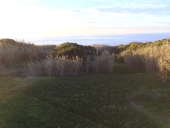Thank you for starting this thread! I had been meaning to start one about this article since seeing it via one of my other channels a few days ago.
When I saw it I immediately thought of Judith Browning's
long-running thread about her beloved peach trees that she calls, among other names, "Cherokee or Indian" peaches. The naming is very suggestive...
The thought of peaches 13 inches in diameter really fires my imagination.
I have feral peach trees in my own yard that fruit every year (albeit in unreliable amounts and subject to all manner of defects, pests, and diseases) that grew up from pits that fell from a tree that in turn grew up from pits tossed by a man who died two decades before I ever set foot on this property. So I don't find the article all that implausible.
The other thing that had primed me to be receptive to this article is having encountered a peach tree at an estate sale about a month ago with a trunk more than eight inches thick. Nobody present could tell me what if any fruiting history it had, but it was clearly a well-cared-for tree. Every other peach tree I've ever seen has been (I figure) on dwarfing root stock or is young (most seem to die within a few decases from the various insect pests) but this tree was magnificent. I'm going to drive by next spring and see how it flowers.
The way I figure, the "these few insect pests evolved to attack peaches and that's why we don't have invasive peach forests any more" story is a bit too facile and simple to be a complete explanation. Indeed, from various examples given, it sounds as if we really do have quite a few wild peach trees left in America, in strange forested corners here and there. A huge part of why we don't have wild peach forests may simply be that we don't have many wild forests period.
I find myself wondering if anybody is maintaining a library or seed bank of wild peach pit/seed genetics. The wild and feral peaches that do survive must surely be a reservoir of genetics that are most resistant to the insect, bacterial, and other pests that knocked back the invasive forests described in the article, right?
I have this vision of setting up a central seed bank of wild peach pits by inviting everybody who knows where to find a wild peach tree to collect pits and send them in along with suitable metadata (description of the wild peach tree from which the pits were collected and the peaches that yielded up the pits) and a small sum of money for postage. Then once a year their "deposit" would be repaid with a return of a similar (but lesser, so that the bank can grow) number of seeds from other depositors. In this wise we might eventually recover some of those marvelous genetics like the volleyball-sized peaches.














